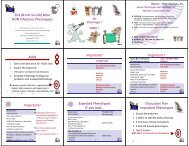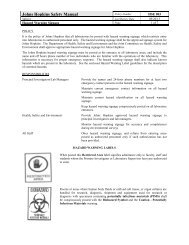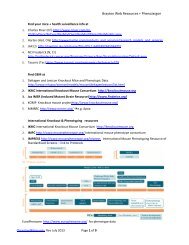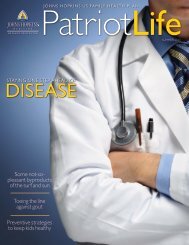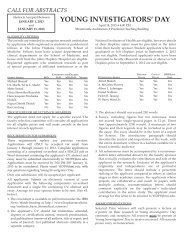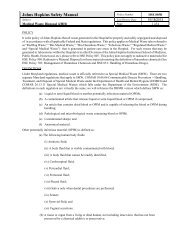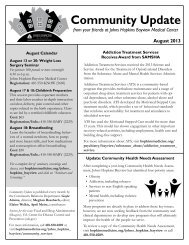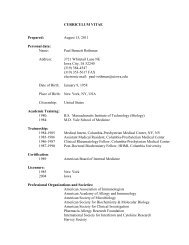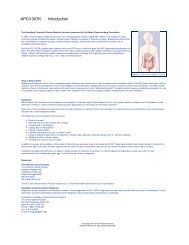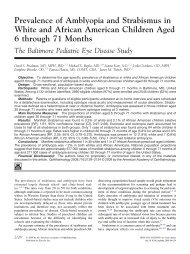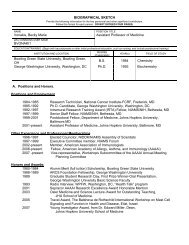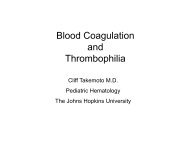Overview Key Concepts Anesthetic Management Anesthestic ...
Overview Key Concepts Anesthetic Management Anesthestic ...
Overview Key Concepts Anesthetic Management Anesthestic ...
Create successful ePaper yourself
Turn your PDF publications into a flip-book with our unique Google optimized e-Paper software.
Small animal Anesthesia for Imaging<br />
C Garrett 2012<br />
ANESTHESIA AND OTHER<br />
CLINICAL CONSIDERATIONS<br />
FOR SMALL ANIMAL IN VIVO<br />
IMAGING<br />
Caroline Garrett, DVM<br />
Clinical Laboratory Animal Resident<br />
Research Animal Resources<br />
Johns Hopkins University<br />
<strong>Overview</strong><br />
‣<strong>Key</strong> <strong>Concepts</strong><br />
‣Anesthesia<br />
‣ Injectable<br />
‣ Inhalant<br />
‣Physiologic monitoring<br />
‣Supportive care<br />
‣ Fasting<br />
‣ Heat support<br />
‣ Fluid Therapy<br />
<strong>Key</strong> <strong>Concepts</strong><br />
‣ The principal goal of anesthesia for in vivo imaging is to<br />
produce a drug-induced state of immobilization that allows<br />
for acquisition of repeatable and reliable data.<br />
‣ <strong>Anesthetic</strong> agents should have minimal impact on the<br />
systems under study.<br />
‣ No anesthetic event is benign. Anesthesia should be safe<br />
and delivered in an approach that limits morbidity and<br />
mortality.<br />
<strong>Anesthetic</strong> <strong>Management</strong><br />
No single agent or combination is appropriate<br />
for all anesthetic events<br />
‣ What is the anticipated duration of immobilization?<br />
‣ What are the number of subject(s) to be imaged?<br />
‣ What route of anesthetic delivery is available?<br />
‣ What agents can be used safely during the imaging<br />
study?<br />
‣ What physiologic parameter(s) are important to the<br />
study?<br />
<strong>Anesthestic</strong> Selections<br />
Understand your model and your<br />
mouse (or rat)!<br />
‣ Strain sensitivity<br />
Flecknell et al. Lab Anim 20:85 – 90 (1996)<br />
1
Small animal Anesthesia for Imaging<br />
C Garrett 2012<br />
<strong>Anesthestic</strong> Selections<br />
Understand your model and your<br />
mouse!<br />
‣ Strain sensitivity<br />
‣ Genetic modifications (e.g. γ-PKC -/- )<br />
Sonner et al. Anesth Analg 89:1030 – 40 (1999)<br />
<strong>Anesthestic</strong> Selections<br />
Understand your model and your<br />
mouse!<br />
‣ Strain sensitivity<br />
‣ Genetic modifications (e.g. γ-PKC -/- )<br />
‣ Co-morbidities<br />
‣ Organ dysfunction (e.g. DCM, hepatitis, renal<br />
tumors)<br />
‣ Physiologic changes (e.g. hypertension,<br />
bradycardia)<br />
General Anesthesia<br />
1. Loss of consciousness<br />
2. Suppression of muscle activity<br />
3. Analgesia<br />
‣ Single agents (e.g. inhalants)<br />
‣ Combinational therapy (e.g. injectables)<br />
All anesthetic agents have side-effects!<br />
Inhalant Anesthesia<br />
Pros ‣ Rapid induction and<br />
recovery<br />
‣ Titration to effect<br />
‣ Fine control over depth<br />
‣ Minimal residual side-effects<br />
Cons<br />
‣ Newer agents: minimal<br />
organ metabolism<br />
‣ Respiratory depression<br />
‣ Require specific equipment<br />
(e.g. vaporizer, intubation or nose<br />
cone)<br />
Injectable Anesthesia<br />
‣ Does not require specific<br />
equipment<br />
‣ Many types/ combinations<br />
‣ Familiarity<br />
‣ Delayed anesthetic<br />
induction and recovery<br />
‣ Variable side-effects<br />
‣ Renal/hepatic metabolism<br />
‣ Often blind administration<br />
Injectable Anesthesia<br />
‣ Pentobarbital: potentiates GABAnergic neurotransmission<br />
‣ Frequently used agent: hypnosis → anesthesia<br />
‣ Cardiopulmonary depression is dose-dependent<br />
‣ May require ventilatory support with severe respiratory depression<br />
‣ Administration: Mice 50 – 90 mg/kg; Rats 30 – 45 mg/kg (IP)<br />
‣ 2-2-2 Tribromoethanol (Avertin®):<br />
‣ Short-acting 15- 30 minutes of anesthesia<br />
‣ Good muscle relaxation, mild respiratory depression<br />
‣ Purchased as a chemical grade product and requires reconstitution<br />
‣ Light and temperature sensitive: degraded bi-products can cause delayed<br />
nephro/hepatotoxicity and gastrointestinal stasis<br />
‣ Increased fatalities with multiple IP administrations (best for single survival<br />
terminal/acute use)<br />
2
Small animal Anesthesia for Imaging<br />
C Garrett 2012<br />
Injectable Agents<br />
‣ Ketamine (Ketaset®): NMDA receptor antagonist<br />
‣ Not recommend as sole anesthetic (increased muscle<br />
tone, tremors, occasional seizures)<br />
‣ Typically used in combination with sedatives,<br />
tranquilizers, and opioid analgesics<br />
‣ Indirect sympathomimetic agent<br />
‣ Increased HR, CO, MAP<br />
‣ Increased cerebral blood flow and metabolic rate<br />
‣ Increased intracranial and intraocular pressure<br />
Injectable Agents<br />
‣ Xylazine (Rompun®): α-2 adrenergic receptor agonist<br />
‣ Commonly used in combination with ketamine<br />
‣ Induces a deep plane of anesthesia for 25 – 40 minutes<br />
‣ Sedation, muscle relaxation, analgesic properties<br />
‣ Reversible agent (e.g. yohimbine or atipamazole)<br />
‣ Medetomidine (Domitor®): α-2 adrenergic receptor agonist<br />
‣ More potent and longer lasting when compared to xylazine<br />
‣ Side effects:<br />
‣ Moderate to serve cardiopulmonary depression (bradycardia, occasional<br />
1 st or 2 nd degree AV-block, peripheral vasoconstriction)<br />
‣ Increased stroke volume as compensation<br />
Caution with vascular perfusion and cardiac studies<br />
Inhalant Anesthesia<br />
‣ Stages of Anesthesia:<br />
1. Induction<br />
2. Maintenance: know the MAC<br />
3. Recovery<br />
‣ Delivery: Precision calibrated vaporizer<br />
‣ Nose-cone<br />
‣ Intubation: airway protection, ventilation<br />
‣ Breathing circuits<br />
» Rebreathing circuits<br />
» Non-rebreathing circuits (e.g. Bain)*<br />
» Minimal dead space and resistance to breathing<br />
» HIGH fresh gas flow ( ≥ 150 mL/kg/min)<br />
Inhalant Anesthesia<br />
‣ Delivery: “Open drop method”<br />
‣ Closed chamber + gauze + anesthetic + animal<br />
‣ Avoid direct animal- anesthetic contact<br />
‣ Monitor anesthetic depth, remove once anesthetized<br />
‣ Best for very quick (30-45 sec) procedures<br />
To calculate dose:<br />
Assume most inhalants: 1 mL liquid 200 mL vapor<br />
Amount liquid anesthetic (mL) = % for induction X vol. jar<br />
200 mL vapor/mL liq<br />
‣<br />
Intubation<br />
Inhalants<br />
Not all inhalants are equal<br />
Slant board: ≥45°<br />
Endotracheal tube size:<br />
Rats: 22 – 20 G catheter<br />
Mice: 24 – 22 G catheter<br />
Oropharyngeal transillumination<br />
‣ Variable Minimum Alveolar Concentration (MAC)<br />
‣ MAC = the concentration of inhaled gas required to block a response to<br />
surgical stimulus in 50% of patients<br />
‣ Potency = 1/ MAC<br />
‣ Variable blood/gas solubility<br />
‣ Solubility 1/ change in the rate of anesthetic depth<br />
‣ Common volatile liquid anesthetic agents<br />
‣ Isoflurane (Forane®)<br />
‣ Sevoflurane (Ultane®)<br />
‣ Cardiac function in general is better maintained with gas (vs injectables)<br />
‣ Good muscle relaxation, rapid recovered<br />
3
Small animal Anesthesia for Imaging<br />
C Garrett 2012<br />
Physiologic Monitoring<br />
Minimal change in homeostasis<br />
‣ Challenging in the imaged patient<br />
‣ Visualization<br />
‣ Adaptable equipment<br />
‣ Parameters to monitor and control<br />
‣ Heart rate<br />
‣ Respiratory rate<br />
‣ Temperature<br />
‣ %SpO 2<br />
‣ ETCO 2<br />
‣ Cardiac activity (EKG)<br />
‣ Blood pressure<br />
Physiologic Monitoring<br />
‣ Pulse oximetry:<br />
‣ Arterial Hb %SpO 2<br />
‣ NIBP: Doppler<br />
‣ Temperature<br />
Rat<br />
Mouse<br />
‣Mouse:<br />
Normal Physiologic<br />
Parameters<br />
‣ Temperature: 97.5 – 100.4°F<br />
‣ Respiratory rate: 150 – 220 bpm<br />
‣ Heart rate: 550 – 700 bpm<br />
‣Rat:<br />
‣ Temperature: 96.6 – 99.5°F<br />
‣ Respiratory rate: 65 - 115 bpm<br />
‣ Heart rate: 250 – 450 bpm<br />
Fasting<br />
‣ Depends on your study and imaging modality<br />
‣ Ex: PET FDG imaging<br />
‣ Decreases blood glucose<br />
‣ ~ 6 hrs fast clears stomach, longer can be detrimental<br />
reduced body mass, fatty acid levels, water intake)<br />
‣ Rodents are nocturnal feeders<br />
Length and timing of fast should be<br />
documented<br />
Fluid Therapy<br />
‣ Prolonged anesthetic events lead to sensible and insensible<br />
water losses<br />
‣ Cautious use of fluids in models of cardiovascular disease<br />
or hypoproteinemic subjects (e.g. hepatic, renal or<br />
gastrointestinal compromise)<br />
‣ Administration routes: subcutaneous, intraperitoneal or<br />
intravascular<br />
‣ Compensate for fluid loss and administer daily<br />
maintenance requirements (50 – 100ml/kg/day)<br />
‣ Pre-warmed (37°C ) fluids: 0.9% NaCl or LRS<br />
Heat Support<br />
‣ Rodents have an incredibly large surface area to body mass<br />
ratio → rapid hypothermia<br />
‣ Prolonged anesthetic recovery<br />
‣ Altered cardiovascular function<br />
‣ Heat support maintained until ambulation<br />
‣ Heating options: Image modality dependent!<br />
‣ Self-regulating heating blocks<br />
‣ Water-circulating heating pads<br />
‣ Insulation (e.g. saran wrap)<br />
‣ Pre-warmed subcutaneous fluids<br />
‣ Hand-warmers<br />
‣ Heat lamps<br />
4
Small animal Anesthesia for Imaging<br />
C Garrett 2012<br />
Heat Support<br />
Rat<br />
Mous<br />
e<br />
Health and Biosecurity<br />
‣ Disinfect anesthetic equipment (e.g. nose-cones,<br />
induction chambers, heating elements) between<br />
subjects.<br />
‣ Typically the imaging core is in a barrier facility,<br />
but…<br />
‣ Once fully recovered (ambulatory), return to facility high<br />
risk suite (e.g. JHU BRB 16A &G and 20A).<br />
Questions?<br />
Research Animal Resources<br />
Veterinary Support<br />
Ross 459<br />
410.955.3273<br />
http://www.hopkinsmedicine.org/animalresources/index.html<br />
5
Research Animal Resources (RAR)<br />
720 Rutland Avenue<br />
Ross Building, Room 459<br />
Baltimore, MD 21205-1191<br />
General information: 410-955-3273 Fax 410-502-506<br />
Clinical calls: 410-955-3273<br />
Animal orders: 410-955-3713<br />
Website: www.hopkinsmedicine.org/animalresources/<br />
Veterinary Consults • Technical assistance • Animal Imports/Exports • Health Certificates •<br />
Anesthesia and Surgical Support<br />
RAR is the centralized providerof veterinary medical care and research animal support at Johns<br />
Hopkins. The office is open Monday- Friday 8:30 am -5 pm. For emergency veterinary assistance<br />
after hours, please call the on-call pager: 410-283-0929.<br />
Johns Hopkins Animal Care and Use Committee<br />
1620 McElderry Street<br />
Reed Hall, Room B122<br />
Baltimore, MD 21205-1911<br />
Phone: 443-287-3738 Fax: 443-287-3747<br />
Email: acuc@jhmi.edu<br />
Website: www.jhu.edu/animalcare<br />
ACUC Policies and Guidelines • Rodent Drug Formulary • JHU “Blue Book” (species specific<br />
information)• Animal Welfare Concerns • Protocol Submission Forms<br />
All studies, courses and training programs proposing the use of animals must be approved by<br />
the Institutional Animal Care and Use Commitee
Mouse Injectable ANestHESIA DOSES<br />
Rat Injectable ANestHESIA DOSES<br />
Anesthesia, Analgesia and Monitoring References<br />
Exotic Animal Formulary, Second Edition, Carpenter, Mashima, Rupiper, 2001<br />
Laboratory Animal Medicine, Second Edition, Fox, Anderson, Loew, Quimb, 2002<br />
Ferrets, Rabbits, and Rodents Clinical Medicine and Surgery, 2 nd Edition, Quesenberry/ Carpenter, 2003<br />
Veterinary Drug Handbook 6th edition. Plumb 2008<br />
Veterinary Anesthesia and Analgesia 4th edition Tranquilli 2007



